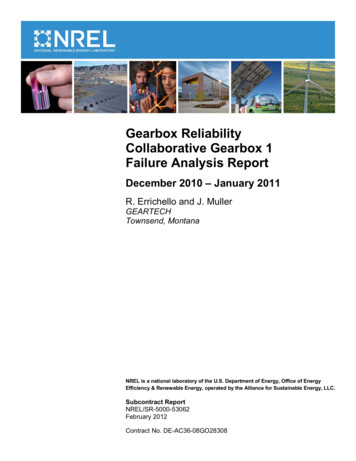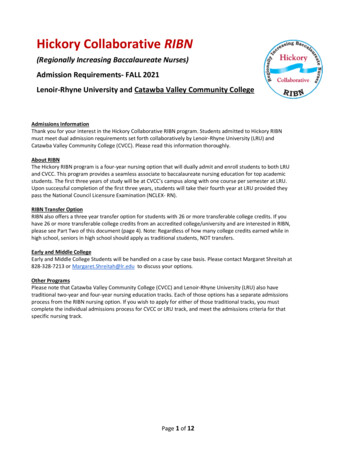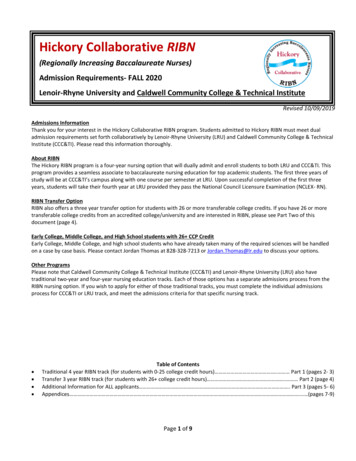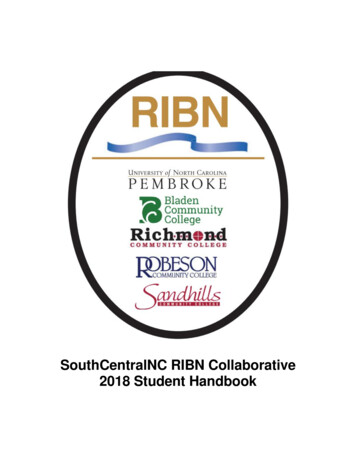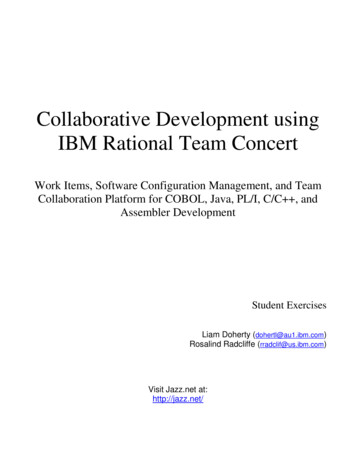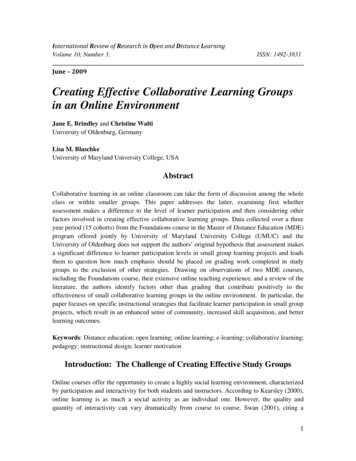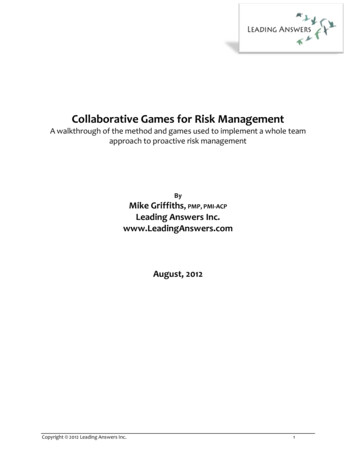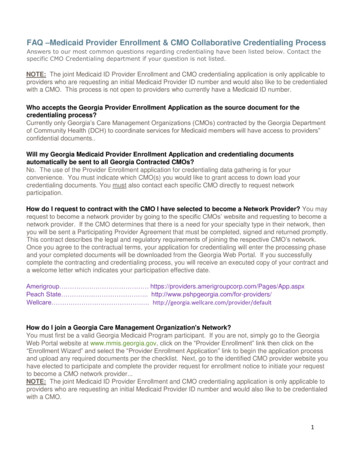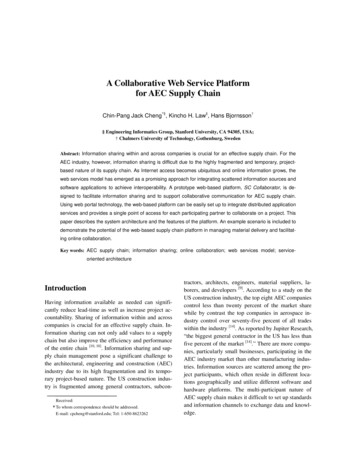
Transcription
A Collaborative Web Service Platformfor AEC Supply ChainChin-Pang Jack Cheng*§, Kincho H. Law§, Hans Bjornsson†§ Engineering Informatics Group, Stanford University, CA 94305, USA;† Chalmers University of Technology, Gothenburg, SwedenAbstract: Information sharing within and across companies is crucial for an effective supply chain. For theAEC industry, however, information sharing is difficult due to the highly fragmented and temporary, projectbased nature of its supply chain. As Internet access becomes ubiquitous and online information grows, theweb services model has emerged as a promising approach for integrating scattered information sources andsoftware applications to achieve interoperability. A prototype web-based platform, SC Collaborator, is designed to facilitate information sharing and to support collaborative communication for AEC supply chain.Using web portal technology, the web-based platform can be easily set up to integrate distributed applicationservices and provides a single point of access for each participating partner to collaborate on a project. Thispaper describes the system architecture and the features of the platform. An example scenario is included todemonstrate the potential of the web-based supply chain platform in managing material delivery and facilitating online collaboration.Key words: AEC supply chain; information sharing; online collaboration; web services model; serviceoriented architectureIntroductionHaving information available as needed can significantly reduce lead-time as well as increase project accountability. Sharing of information within and acrosscompanies is crucial for an effective supply chain. Information sharing can not only add values to a supplychain but also improve the efficiency and performanceof the entire chain [10, 18]. Information sharing and supply chain management pose a significant challenge tothe architectural, engineering and construction (AEC)industry due to its high fragmentation and its temporary project-based nature. The US construction industry is fragmented among general contractors, subconReceived:﹡To whom correspondence should be addressed.E-mail: cpcheng@stanford.edu; Tel: 1-650-8623262tractors, architects, engineers, material suppliers, laborers, and developers [9]. According to a study on theUS construction industry, the top eight AEC companiescontrol less than twenty percent of the market sharewhile by contrast the top companies in aerospace industry control over seventy-five percent of all tradeswithin the industry [14]. As reported by Jupiter Research,“the biggest general contractor in the US has less thanfive percent of the market [14].” There are more companies, particularly small businesses, participating in theAEC industry market than other manufacturing industries. Information sources are scattered among the project participants, which often reside in different locations geographically and utilize different software andhardware platforms. The multi-participant nature ofAEC supply chain makes it difficult to set up standardsand information channels to exchange data and knowledge.
2Supply chain management tools exist to help managers to deal with project management tasks. However,most of the tools focus their applications in the manufacturing industry. These tools are not suitable for theAEC industry since they are targeted for large manufacturers and retailers with relatively stable supplychains, and they rarely include upstream design anddownstream operational activities. Implementation andconfiguration of these tools are complex and oftentime-consuming. AEC supply chains are characterizedby its temporary, project-based nature. That is, thesupply chains change from project to project and, inmost cases, cannot afford to spend much time for system configuration and deployment. In other words, anapplication for the AEC industry needs to be easilyconfigured to accommodate different supply chains.Effective and flexible information sharing and serviceintegration are important for supporting supply chainactivities in the AEC industry.The Internet has emerged as the most cost effectivemeans of driving supply chain integration and information sharing [11]. Companies have begun to take advantage of the Internet and information technology to create a virtual supply chain where business partners cancommunicate and collaborate with each other [15]. TheInternet can serve as the medium for information andservice integration, engineering simulation, and othercollaborative tasks [6, 17]. In this paper, we present aprototype collaborative system, SC Collaborator, formanaging AEC supply chains. The system integratesdistributed information sources and web applicationsutilizing the web services model. Web portal technology is leveraged to provide each project participant asingle point of access to the integrated network of information and services. The system architecture andfeatures of the system are discussed in this paper. Anexample scenario is also included to demonstrate thepotential of the system to manage the information flowin AEC supply chains.1Web Services ModelWith the rapid development of communication technologies, the Internet has become ubiquitous and instantaneously accessible. Together with the rapidgrowth of online information sources, the web servicesmodel is a desirable approach to connect remote software applications and information sources, utilizingwell established Internet protocols and commonly usedmachine readable representations.A “web service” can be described as a specific function that is delivered over the web to provide information or services to users. It can create dynamic responses and is different from conventional websiteswhich deliver only static information. Although a widevariety of definitions exist, a typical web service canbe said to have the following features: “web servicesare modular, self-describing applications that can bepublished, located and invoked from just about anywhere on the Web or a local network. The provider andthe consumer of the XML web service do not have toworry about operating system, language, environment,or component model used to create or access the XMLWeb service, as they are based on ubiquitous and openInternet standards, such as XML, HTTP, and SMTP[4].” Web services are usually encapsulated. In otherwords, their implementation is not exposed to the users.Changing the implementation of one web service function does not require changes of the invoking function.Many languages have been proposed to facilitate thedevelopment and reuse of web services. Examples include Web Services Description Language (WSDL) [3]and Flow Language (WSFL) [12], Business ProcessExecution Language for Web Services (BPEL4WS) [1],and Web Service Ontology based on DARPA AgentMarkup Language (DAML-S) [2]. There are many research efforts on web-based service integration [5, 8],which deals with the mechanisms to invoke, terminateand orchestrate web services. Studies on the semanticsof web services have also grown recently [7].One key idea of the web services model is its implementation of the service-oriented architecture(SOA). SOA is a model in which information sourcesand software functionality are delivered as individualdistinct service units, which are distributed over a network and combined to create business applications tosolve complex problems. SOA facilitates interoperability among information sources and systems, which areconverted into modular and flexible service components that can be requested through a standard protocol.The components can be reused by multiple applications or other services resided in a network. They canbe updated or replaced without affecting the functionality or integrity of other independent services. Reusability enables modular system and application devel-
3Chin-Pang Jack Cheng, Kincho H. Law, Hans Bjornsson:A Collaborative Web Service Platform opment, and is essential for building a flexible systemfor fast changing supply chains.2SC onApp 1Application-toapplication interoperationWrapperApp 3Portlet gatewayWrapperLeveraging the web services model, we have developed a prototype web-based collaborative system, SCCollaborator (see Fig.1). SC Collaborator is a collaborative platform designed for supporting AEC activitiesand integrating loosely coupled information and services. The platform provides each participant a singlepoint of access to the needed information and servicesusing the web portal technology. The platform is developed using open source tools and can be installedand configured easily.2.1Web Portal TechnologyA web portal is a web-based application that acts as agateway to a larger system or a network of web applications. It is a useful tool to aggregate scattered, distributed information and services into a single point ofaccess. Web portal has been commonly used as a repository of information and documents within companies or between business partners for content management [16]. There is also an increasing trend to developand publish websites via web portals, which allow personalized settings and configurations.Web portal is a container of multiple web portlets,which are sub-programs that encapsulate a single or anumber of web applications. Portlets do not generate acomplete HTML code, but only a fragment of it whichis subsequently aggregated by the web portal to form aFig. 1SC Collaborator viewed in web browsersWrapperPortlet gatewayFragmentsof HTMLFig. 2App 2Fragmentsof HTMLWeb Portal SystemPortlet gatewayFragmentsof HTMLConceptual framework of web portal systemscomplete webpage. Portlets are contained in a web portal in order to be visible and accessible. Web portalsalso manage the portlet sessions and store the portletpreferences.As illustrated in Fig. 2, applications and informationsources are wrapped and deployed as individual webportlets, which are web service units that a web portalsystem can integrate and reuse. Through the portal system, multiple applications can be accessed, related andintegrated into a workflow or a supply chain. A webportal system provides the clients a single point of access to information and applications regardless of theirlocation or storage mechanism. Clients can access tomultiple systems or applications with a single authentication.2.2 System ArchitectureFig. 3 shows the system architecture of SC Collaborator. On the server side, SC Collaborator is divided intothree tiers – the web server / servlet container tier, thebusiness implementation tier and the database tier. Theservlet container tier allows clients to access the system through standard web services protocol by SOAPmessaging and WSDL description, through wirelessdevices by Wireless Markup Language (WML), orthrough web browsers. The business implementationtier provides connectivity to the database, manages thesessions of the system, manages the information transaction, and performs business functions. The databasetier serves as the back-end information source to support the whole platform. It stores information such asuser privileges and settings, portal and portlet configurations, and page layout settings.The business tier consists of the Plain Old Java Object (POJO) implementation core and two supportingframeworks, which are all bundled in the Liferay Portal [13]. The POJO implementation core takes the com-
reJavaclassesJDBCWebServicesDatabases orweb servicesWeb Server Tier[Apache Tomcat]ClientsBusiness Tier[Liferay Portal]Database Tier[MySQL]ServerFig. 3System architecture of SC Collaboratorputational job and connects to other applications orweb services. The core is extended with two lightweight frameworks, Hibernate and Spring. The Hibernate framework maps the objects in the relational database into Java object-oriented classes. The Springframework wraps the POJO core and provides additional features such as messaging, session managementand transaction ticsSC Collaborator is a web-based solution to integratedistributed information sources and engineering services and suits the needs of the multi-participant, fastchanging AEC supply chains. The system provides aneconomical solution by adopting open source technologies, supports flexible configuration and modulardevelopment with SOA, ensures delivery of right information to the right person, and provides a unifiedeasily accessible user interface.2.3.1 Open Source SoftwareThe three tiers of SC Collaborator are implementedwith open source software – Apache Tomcat, LiferayPortal and MySQL. Therefore, SC Collaborator provides an economical and desirable platform for theAEC companies, which are usually medium to small insize and reluctant to invest on a system that requiresfrequent changes.2.3.2 Service-Oriented Architecture (SOA)In SC Collaborator, each web portlet encapsulates oneor more web applications and acts as a web servicecomponent unit of an integrated service network. TheSOA structure makes SC Collaborator flexible andscalable, and allows agile configuration and development. System developers can consider each portlet as aseparate component and implement the portlet functionalities independent of the other part of the system.The separation of portlets also allows greater systemflexibility and scalability. Whenever there is a changein the integrated network, only the relevant portlet services need to be added, extended, modified or removed.The system, therefore, can be quickly reconfigured forany changes in the supply chain activities. In addition,the ability to reuse the portlets saves time and effortwhen building a system for a new project.2.3.3 Information DeliverySC Collaborator is a role-based system. It can be customized so that some modules or portlets are availableonly to the designated roles. For example, the administrative module may be accessible by the main contractor but not the suppliers. Some modules or portlets areavailable for all roles in the system. However, the functionalities and the rights of access may vary among theusers of different roles. For instance, in the materialsmanagement module a subcontractor can change itsown procurement orders, whereas the main contractorcan only view the part lists.Although clients of the same role usually need the
Chin-Pang Jack Cheng, Kincho H. Law, Hans Bjornsson:A Collaborative Web Service Platform same information and functionalities, they may havedifferent working styles and preferences. The portalsystems can also be personalized to provide individualized configurations, layout and preferences. In this way,SC Collaborator ensures that the right amount of information is delivered at the right time to the right person.2.3.4 Unified, Easy-to-Access User InterfaceSC Collaborator provides the clients a single point ofaccess to information sources and applications. A single authentication of the system allows clients to gainaccess to multiple systems or applications with a unified user interface. This reduces the effort to manage anetwork of systems. While some collaborative systemsrequire the client-side to install particular communication software in order to be connected for collaboration,the users of SC Collaborator can access the system viaweb browsers. The usability of the system is thereforeenhanced.3 Example ScenarioThe example illustrated in Fig. 4 demonstrates theMessage received by MEP Subcontractoronline collaboration and information flow among ageneral contractor, subcontractors and suppliers usingSC Collaborator to manage material delivery. In thisexample, one of the suppliers of the MEP subcontractor has to delay the material delivery of two items. Asshown in Fig. 4, the delay notice sent by the supplierstriggers a message in SC Collaborator delivered toboth the general contractor and the MEP subcontractor.The general contractor provides the subcontractor twooptions – to change the supplier so that the scheduleremains unchanged, or to request a task delay with apenalty. The subcontractor uses SC Collaborator toconnect to the systems of the suppliers with partnership agreements, and checks the available alternativesuppliers for the two items. The subcontractor findsthat one of the items is out of stock among the partnersuppliers, which means that a task delay is unavoidable.The subcontractor then makes a schedule delay for theaffected task in SC Collaborator, as illustrated in Fig. 4.All the project participants obtain an updated scheduleinstantly to plan and revise their tasks. This exampledemonstrates the potential of using SC Collaborator toconnect distributed web applications and services, andSchedule updated by MEP SubcontractorRequests of quote and availability sent to partner suppliers’ web servicesFig. 45Project collaboration example scenario using SC Collaborator
6to act as a unified communication channel among project participants.[3]4 Conclusions and Future WorkCurrent supply chain tools are mainly targeted for themanufacturing industry and are not suitable for managing the highly fragmented, project-based AEC supplychains. With the rapid development of Internet technologies, the web services model emerges as a promising approach to integrate loosely coupled informationand applications. With the SOA, the web servicesmodel provides a flexible and modular solution forAEC supply chain integration and collaboration.In this paper, we present SC Collaborator, a prototype web-based portal platform designed to facilitateinformation sharing and support collaborative communication among project partners in AEC supply chain.The platform leverages open source software tools, andenables an easily configurable portal system. For eachparticipant, the web portal provides a single point ofaccess of the information. The illustrative exampleshows the potential of using SC Collaborator for managing material delivery. Other complex modules suchas scheduling, organization and management of material resources are being developed to extend the functionalities and usability of the platform.5 AcknowledgementsThe authors would like to acknowledge the supports bythe US National Science Foundation, Grant No. CMS0601167, the Center for Integrated Facility Engineering (CIFE) at Stanford University, the Enterprise Systems Group at the National Institute of Standards andTechnology (NIST) and Wast-Bygg, AB, Sweden. Anyopinions and findings are those of the authors, and donot necessarily reflect the views of NSF, CIFE, NISTor Wast-Bygg, AB. No approval or endorsement of anycommercial product by NIST, NSF or Stanford University is intended or [16][17]References[1] Andrews T, Curbera F, Dholakia H, et al. Business ProcessExecution Language for Web Services (BPEL4WS).OASIS,” Specification Version, 2003, 1.[2] Ankolekar A, Burstein M, Hobbs J R, et al. DAML-S: Semantic Markup for Web Services. In: Proceedings of the[18]International Semantic Web Working Symposium (SWWS).2001.Booth D, Liu C K. Web Services Description Language(WSDL) Version 2.0 Part 0: Primer. W3C Working Draft,2004, 21.Cauldwell P, Chawla R, Chopra V, et al. Professional XMLWeb Services, Wrox Press, 2001.Cheng J. A Simulation Access Language and Frameworkwith Applications to Project Management. Ph.D. Thesis,Department of Civil and Environmental Engineering, Stanford University, Stanford, CA, 2004.Cheng J, Cheng C P, Thi M A L, et al. Engineering Simulations with Web-based Services. In: Proceedings of the 11thInternational Conference on Computing in Civil and Building Engineering, (ICCCBE XI). Montreal, Canada, 2006.de Bruijn J, Bussler C, Domingue J, et al. Web servicemodeling ontology (WSMO). W3C Member Submission.World Wide Web Consortium (W3C), 2005.Greenwood D, Calisti M, Ag W T, et al. Engineering Webservice-agent integration. 2004
for AEC Supply Chain Chin-Pang Jack Cheng*§, Kincho H. Law§, Hans Bjornsson† § Engineering Informatics Group, Stanford University, CA 94305, USA; † Chalmers University of Technology, Gothenburg, Sweden Abstract: Information sharing within and across companies is crucia
